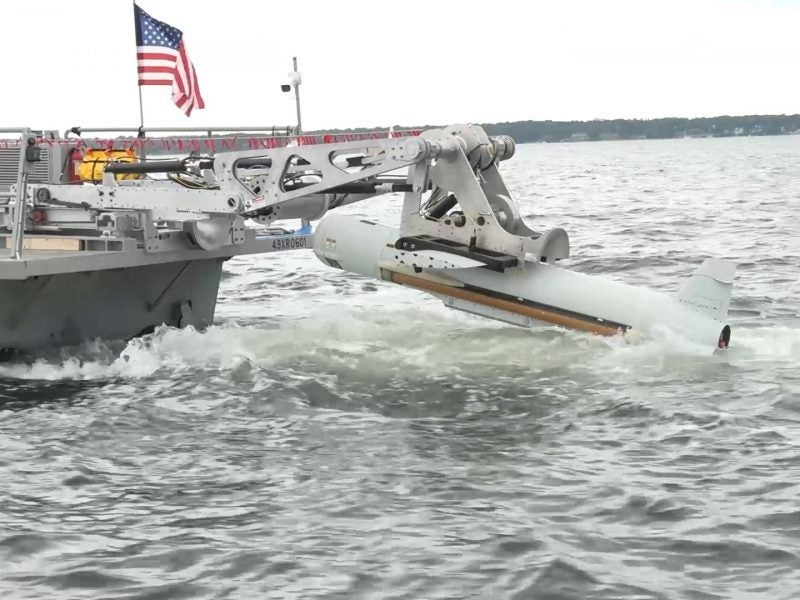
Berenice Baker: What is Raytheon’s background in naval mine countermeasures?
Andrew Wilde: Raytheon has a long pedigree in this field, and it’s a very exciting time for us in terms of our mine neutralisation portfolio. We’ve been working on advanced concepts of operations with the US Navy for some time now, beginning with a programme called the Airborne Mine Neutralisation Programme which is a helicopter-based mine neutralisation system that uses BAE Systems effectors.
Why is the single-sortie concept important for minehunting?
We realised working with the navy that using the AQS-20 minehunting sonar with a traditional mine neutralisation system was just too slow, so we worked over the last several years with the Office of Naval Research to develop a concept called ‘single sortie detect-to-engage’ with an unmanned service vessel.

Discover B2B Marketing That Performs
Combine business intelligence and editorial excellence to reach engaged professionals across 36 leading media platforms.
We demonstrated this during ANTX 2019 using a Textron mine countermeasure unmanned surface vehicle equipped with our AQS-20 minehunting sonar with an automated deploy and retrieval system and our Barracuda autonomous mine neutraliser, which is an A-size device, being a standard sonar-buoy size form factor. We were able to show that an unmanned surface vessel deployed AQS-20, found a mine-like object, and deployed the Barracuda mine neutraliser, which successfully found and neutralised the mine.
We think it’s going to revolutionise mine countermeasures, using unmanned autonomous surface vessels to do this work in a very fast, single pass to detect and neutralise a mine. It takes humans further out of harm’s way and reduces the timeline to neutralise a large minefield from months down to weeks or even days.
The AQS-20 is platform agnostic, and as well as working with Textron on the US Navy’s programme of record, ASV Global [now an L3 company], Atlas Elektronik UK and others have unmanned surface vessels that can accommodate this form factor. We’re very excited about being able to team with international partners to provide this capability globally.
What’s the next step for this programme?
Raytheon is firmly committed to mine countermeasures, so we continue to invest internally as well as with the US Navy in improving our AQS-20, which is the most advanced mine-hunting sonar on the market today.

US Tariffs are shifting - will you react or anticipate?
Don’t let policy changes catch you off guard. Stay proactive with real-time data and expert analysis.
By GlobalDataThe Barracuda mine neutraliser is a new programme we’re working on with the US Government. It’s just passed its preliminary design review with the US Navy and we’re continuing to work through that development programme. We’re co-investing with the US Navy in order to make this tested technology even better. Demonstrating the durability was a huge step for us; it’s been under development for many years, so we were very excited about that.
The next steps are to show friends and allies across the globe that have mutual adversaries that use mines – this very inexpensive way to try and close down sea lanes – how to defeat them.
What are the main challenges in the modern minehunting environment?
We have capable adversaries with equally capable mines, which can be planted very deep or in such a way that they’re camouflaged. Raytheon is really focused on, in particular, advancing the synthetic aperture sonars that we produce in order to be able to find these very difficult targets.
What other undersea technologies is Raytheon working on?
We are delivering our first SQS-62 variable depth sonar to the navy as we speak. Raytheon has been working very closely with the navy for a number of years to develop this sonar system to provide a very capable end-to-end engagement chain.
Raytheon also produces the Mark 54 lightweight torpedo which is a mainstay for our NATO allies. The sonar is lightweight, compact, digital, and approved for export so we can support our allies in Europe and the Far East so our navies are fully interoperable. It uses the most modern digital technology to coordinate with the Mark 54 torpedo, making it a very compelling and very capable solution.
Right now we’re working with the navy to come up with a concept of operations using the simulation capabilities we’ve developed so that we can show that the US Navy and Raytheon going forward are invested in undersea technologies that work best, and we’re coming up with missions that make sense.





